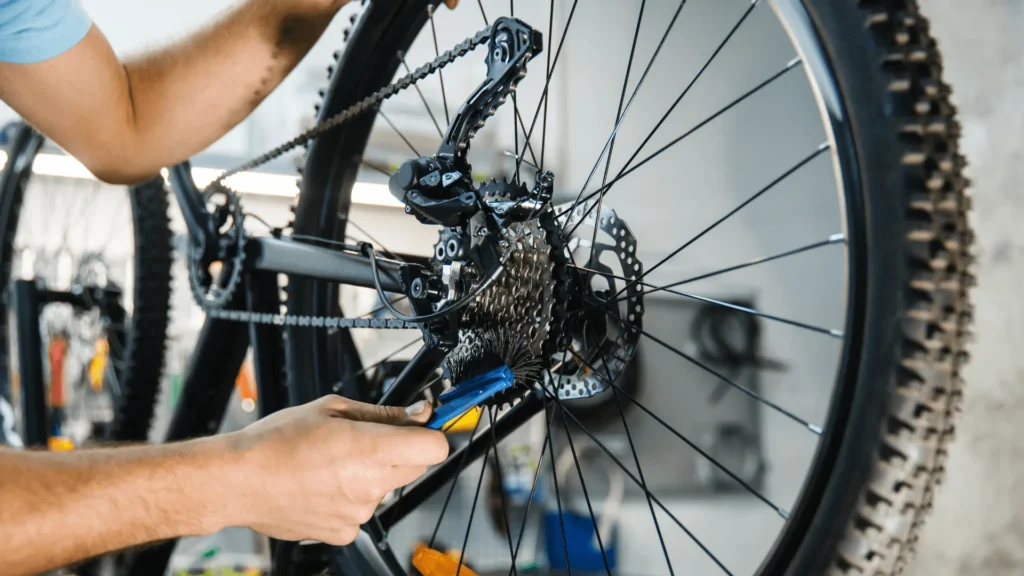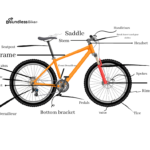Are you a cycling enthusiast or just starting out on your biking journey? If so, then you might have come across the term “bike cassette”. But do you know what it means and how it affects your cycling experience? Don’t worry; we’ve got you covered in this blog post. We’ll break down everything about bike cassettes – from their purpose to the different types available out there. By the end of this article, you’ll be able to choose the right bike cassette for your needs and even install or change one yourself! So grab a cup of coffee, sit back, and let’s dive into the world of bike cassettes.
What is a Bike Cassette?

A bike cassette is a part of the bicycle drivetrain system that contributes significantly to the smooth functioning of your bike. The cassette consists of multiple sprockets or cogs attached to the rear wheel hub. These sprockets are held together by a spider and mounted on a freehub, which allows them to rotate freely when you pedal.
The number of teeth on each cog varies in size, creating different gear ratios that enable you to shift gears according to varying terrain or riding conditions. Typically, road bikes have cassettes with anywhere from 8-11 sprockets, while mountain bikes may have up to 12 sprockets.
By changing gears using the cassette, you can adjust your pedaling cadence and effort required for cycling uphill or downhill. Therefore, it’s essential to choose a bike cassette that matches your cycling needs and preferences.
What is the Cassette on a Bike?
The cassette on a bike is an essential component of the drivetrain that allows you to change gears smoothly and efficiently. It consists of a cluster of sprockets mounted on the rear wheel hub, with each sprocket having different teeth count for varying gear ratios.
When you shift gears using the shifters at your handlebars, the derailleur moves the chain up or down onto another sprocket in the cassette, changing your gear ratio and making pedaling easier or harder depending on terrain conditions.
Choosing the right bike cassette depends on various factors such as your fitness level, riding style, terrain preference, and desired gear range. A wider range will give you more options for climbing hills and steep terrains while sacrificing top-end speed.
Installing or changing a bike cassette requires some specialized tools like a chain whip and lockring tool. It’s recommended to have it done by a professional mechanic if you’re not confident doing it yourself.
Understanding what is a bike cassette is crucial in maintaining proper shifting performance and achieving optimal efficiency during rides. Make sure to choose wisely according to your needs and preferences for an enjoyable cycling experience!
How to Choose the Right Bike Cassette
Choosing the right bike cassette is crucial for a smooth and efficient ride. The cassette determines how easily you can pedal up hills, how fast you can go on flats, and how quickly you can stop. Here are some factors to consider when choosing the right bike cassette:
1) Gear Range: Consider what kind of terrain you will be riding on. If there are lots of steep hills, then a wide range of gears may be necessary.
2) Number of Speeds: The number of speeds in your cassette refers to the number of cogs or sprockets that it has. It’s important to choose a cassette with an appropriate number of speeds that matches your bike’s shifter.
3) Weight: The weight will affect how much energy you need to expend while riding.
4) Compatibility: Make sure that your chosen cassette is compatible with your rear derailleur and chain.
5) Brand Reputation: Some brands have better reputations for quality and durability than others.
How to Install a Bike Cassette
Installing a bike cassette may seem intimidating, but it’s actually a straightforward process that can be done with the right tools. Here are the steps to install a bike cassette:
1. Gather your tools: You’ll need a chain whip, a lockring tool, and potentially an adjustable wrench.
2. Remove the old cassette: Use the chain whip to hold the cassette in place while you use the lockring tool to loosen and remove the lockring.
3. Clean everything: Once you’ve removed the old cassette, take some time to clean both it and your wheel hub.
4. Install new cassette: Slide on your new cassette onto your freehub body making sure it clicks into place securely.
5. Tighten lockring: Use your lockring tool to tighten down on thing until its properly snug (but not too tight).
6. Test ride & adjustment: Give everything another quick check before taking off for test rides!
Remember that installation can vary based on different cassettes so always check manufacturers guidelines if you’re uncertain about anything!
How to Change a Bike Cassette
Changing a bike cassette might seem intimidating, but it’s actually a straightforward process that you can do at home with the right tools. Here are the steps to follow:
1. Remove the rear wheel: Shift your chain onto the smallest cog and release your brakes. Use a quick-release lever or wrench to remove your rear wheel.
2. Remove the lockring: Use a chain whip to hold the cassette in place while using a cassette removal tool and wrench to loosen and remove the lockring.
3. Take off the old cassette: Slide off each individual cog from largest to smallest until all of them are removed.
4. Install the new cassette: Place each cog on in reverse order, starting with your smallest cog first and ending with your largest one last.
5. Tighten everything up: Replace your lockring by screwing it back into place with a wrench, reattach your rear wheel, adjust tension if necessary, then test ride!
Remember that changing out cassettes is an excellent opportunity to clean both wheels’ hub bodies thoroughly!
What are the Different Types of Bike Cassettes?
Bike cassettes come in different varieties, each with its unique set of specifications. The most common types are the mountain bike cassette and the road bike cassette.
Mountain bike cassettes typically have a wide range of gears to help riders tackle steep climbs and technical terrain. They usually come in 9, 10, or 11-speed options and have a large cog that can go up to 50 teeth or more.
On the other hand, road bike cassettes are designed for speed and efficiency on smooth surfaces. They typically have fewer gears than mountain bike cassettes – ranging from 8 to 12 speeds – but offer closer gear ratios for smoother shifting during high-speed rides.
There’s also the gravel-specific cassette that falls somewhere between a mountain bike cassette and a road bike cassette; it’s designed for rougher terrains while still providing efficient performance on paved roads.
Moreover, some brands produce e-bike specific cassettes that can handle higher torque loads produced by electric motors without wearing out as quickly as regular cassettes.
Ultimately, choosing the right type of cassette depends on your riding style and preferences. Make sure you consider factors like gear range, tooth count, weight, durability when selecting which one is best suited for your needs.
| Cassette Type | Number of Speeds | Gear Range | Smallest Cog Size (Teeth) | Largest Cog Size (Teeth) |
|---|---|---|---|---|
| Single-speed Freewheel | 1-speed | – | 14T | 20T |
| Shimano Tourney MF-TZ31 | 7-speed | 14-34T | 14T | 34T |
| Shimano Acera CS-HG200 | 9-speed | 11-32T | 11T | 32T |
| Shimano Deore XT CS-M8100 | 12-speed | 10-51T | 10T | 51T |
| SRAM PG-970 | 9-speed | 11-21T, 11-23T, 11-26T, 11-28T | 11T | 21T, 23T, 26T, 28T |
| SRAM XG-1275 | 12-speed | 10-50T | 10T | 50T |
| SunRace CSMX8 | 11-speed | 11-42T, 11-46T | 11T | 42T, 46T |
| Campagnolo Chorus 11 | 11-speed | 11-29T, 11-32T, 11-34T | 11T | 29T, 32T, 34T |
Pros and Cons of Different Types of Bike Cassettes
There are different types of bike cassettes available in the market, each with its own set of pros and cons. It’s important to choose the right cassette according to your riding style and terrain.
One type is the Shimano HG cassette which has a steel spider for added stiffness and durability. It’s easy to find replacement parts for this type of cassette but it tends to be heavier than other options.
Another option is SRAM PG Cassette which offers a wider range of gears that makes it ideal for steep climbs. However, these cassettes tend to wear out quickly due to their aluminum construction.
Campagnolo cassettes are known for their smooth shifting action thanks to their unique tooth design but they can be pricey compared to other brands.
Furthermore, some riders prefer single-speed or fixed gear setups as they offer simplicity and low maintenance requirements. However, these setups can limit your speed on flats or descents without enough pedaling power.
Ultimately, choosing the best bike cassette depends on personal preference and intended use so weigh up each option before making a decision.
How to Choose the Right Bike Cassette
Choosing the right bike cassette is essential to get the best performance out of your bike. The cassette on a bike has sprockets of different sizes that determine how easy or hard it is to pedal. Here are some tips for choosing the right one:
1. Determine your riding style and terrain: If you live in an area with lots of hills, you may want a cassette with smaller sprockets that provide easier gears for climbing. For flat areas, larger sprockets will give you more speed.
2. Consider your fitness level: If you’re just starting out, a wider range cassette can be helpful as it provides lower gears to make pedaling easier until you build up strength.
3. Think about your bike’s drivetrain compatibility: Not all cassettes are compatible with every type of derailleur or shifter, so make sure the one you choose matches what’s currently on your bike.
4. Look at tooth count and gear ratios: Cassettes come in various tooth counts and gear ratios – each offering different benefits depending on your needs and preferences.
By taking these factors into consideration when selecting a new cassette for your bike, not only will it improve its performance but also enhance overall comfort during rides!
Conclusion
After reading this article, you should now have a good understanding of what a bike cassette is and how it works. Remember that choosing the right bike cassette can greatly affect your riding experience, so it’s important to consider factors such as terrain, desired gear range, and compatibility with your bike.
Whether you’re installing a new cassette or changing an old one, make sure to follow proper installation procedures and use the necessary tools. And don’t forget to maintain your cassette by cleaning it regularly to ensure optimal performance.
There are many different types of bike cassettes available on the market today, each with its own set of pros and cons. So take some time to research which type will best meet your needs before making a purchase.
By understanding how cassettes work and selecting the right one for your ride style, you’ll be able to enjoy smoother shifting and more efficient pedaling on every adventure!
Also Read: Can I Put a Bigger Cassette on My Bike? Quick Guide






